To conduct effective drone inspections in chemical plants, you'll need to master these seven essential tips. Start by carefully planning your flight path and selecting the right drone model for the job. Optimize your camera settings to capture clear, detailed images, and always prioritize safety protocols. Leverage thermal imaging technology to detect hidden issues, and implement robust data management techniques for efficient analysis. Finally, interpret your findings accurately and report them effectively to stakeholders. By following these guidelines, you'll maximize the benefits of drone inspections in your chemical plant. Explore each tip in depth to elevate your inspection game.
Key Takeaways
- Plan flight paths carefully, considering site hazards, weather conditions, and inspection priorities.
- Select drones with high-quality cameras, obstacle avoidance systems, and protective features against corrosive environments.
- Optimize camera settings for exposure, contrast, resolution, and white balance to capture clear, detailed imagery.
- Implement strict safety protocols, including obtaining clearances, conducting pre-flight checks, and monitoring weather conditions.
- Utilize thermal imaging technology to detect temperature anomalies and identify potential issues early.
Plan Your Flight Path Carefully

Planning your flight path is essential for effective drone inspections in chemical plants. You'll need to take into account multiple factors to guarantee safety and efficiency. Start by obtaining detailed site maps and identifying potential hazards like tall structures, restricted areas, and emergency zones.
Factor in weather conditions, especially wind patterns, which can affect your drone's stability and flight performance. Determine your inspection objectives and prioritize areas that require closer examination. Plan your route to cover these areas systematically, avoiding unnecessary backtracking.
Think about battery life and plan for multiple flights if needed, including designated landing zones for battery swaps. Establish clear communication protocols with ground personnel and plant operators. They can provide real-time updates on plant operations that may affect your flight.
Include contingency plans for unexpected events, such as equipment malfunctions or sudden changes in plant activity. Before finalizing your path, conduct a virtual walkthrough using 3D modeling software if available. This can help you identify potential blind spots or challenging areas.
Choose the Right Drone Model
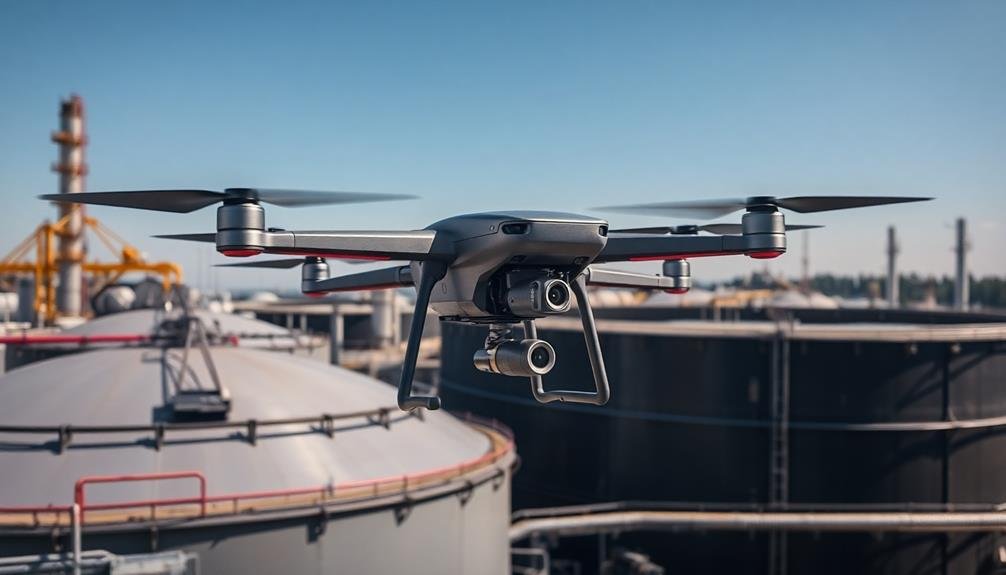
Drone selection is essential for successful chemical plant inspections. You'll need to evaluate several factors when choosing the right model for your specific needs.
First, opt for a drone with a high-quality camera capable of capturing clear, detailed images and videos. Look for models with at least 4K resolution and good low-light performance, as you may need to inspect dimly lit areas.
Ensure your drone has a robust obstacle avoidance system to navigate complex industrial environments safely. Choose a model with multiple sensors and intelligent flight modes to reduce the risk of collisions.
Battery life is critical, so select a drone with extended flight time to complete thorough inspections without frequent landings.
Examine drones with thermal imaging capabilities, as they can help detect heat anomalies in equipment and pipelines.
For chemical plants, it's essential to choose a drone with protective features against potentially corrosive environments. Look for models with sealed motors and weather-resistant bodies.
Optimize Camera Settings for Clarity
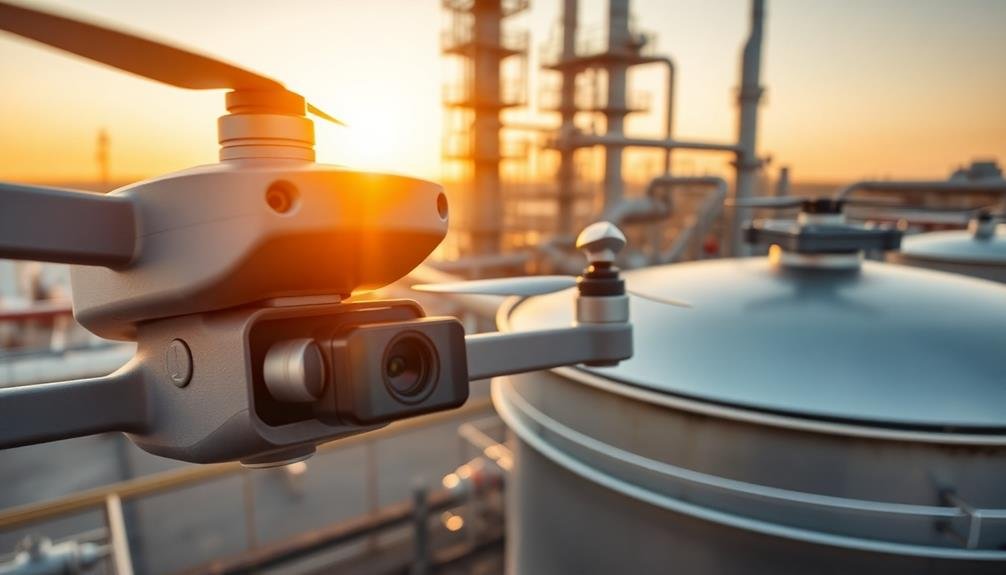
To capture clear, detailed images during chemical plant inspections, you'll need to optimize your drone's camera settings.
Start by adjusting the exposure and contrast to guarantee proper lighting and image definition. Then select the appropriate resolution settings for your specific inspection needs.
Don't forget to use proper white balance to accurately represent colors, which is essential for identifying potential issues or anomalies in the plant's infrastructure.
Adjust Exposure and Contrast
Image quality is essential when conducting drone inspections of chemical plants. To achieve ideal results, you'll need to adjust exposure and contrast settings on your drone's camera. Start by setting the exposure compensation to slightly underexpose your images, typically between -0.3 and -0.7 EV. This helps preserve highlight details in bright areas like reflective surfaces or sunlit equipment.
For contrast, aim for a balance that enhances details without losing information in shadows or highlights. Use your drone's histogram to guide you, ensuring the graph spans the full range without clipping at either end. Here's a quick reference guide for exposure and contrast adjustments:
| Condition | Exposure Compensation | Contrast Setting |
|---|---|---|
| Bright Sunlight | -0.7 to -1.0 EV | Medium-Low |
| Overcast | -0.3 to 0 EV | Medium |
| Shadowed Areas | 0 to +0.3 EV | Medium-High |
| Low Light | +0.3 to +0.7 EV | High |
Remember to review your images frequently during the inspection and make adjustments as lighting conditions change. If you're shooting in RAW format, you'll have more flexibility to fine-tune exposure and contrast in post-processing, but it's still important to get it right in-camera for the best results.
Select Appropriate Resolution Settings
While adjusting exposure and contrast is essential, selecting the right resolution settings is equally important for capturing clear, detailed images during chemical plant inspections.
You'll want to choose the highest resolution your drone's camera supports to guarantee you capture the finest details of equipment, pipes, and structures. Higher resolution allows for better zoom capabilities during post-inspection analysis, enabling you to spot potential issues that mightn't be visible at lower resolutions.
However, be mindful of your drone's storage capacity and flight time when selecting resolution settings. Higher resolutions result in larger file sizes, which can quickly fill up your memory card. They also require more processing power, potentially reducing your drone's battery life.
Strike a balance between image quality and practical considerations.
For most chemical plant inspections, a resolution of 4K (3840 x 2160 pixels) or higher is ideal. If your drone doesn't support 4K, aim for at least 1080p (1920 x 1080 pixels).
Remember to adjust your frame rate as well, typically 24-30 fps for standard inspections or 60 fps if you need to capture smooth footage of moving parts.
Use Proper White Balance
Proper white balance is a essential aspect of optimizing your drone's camera settings for clarity during chemical plant inspections. It guarantees that colors in your footage appear as they do in real life, which is significant for accurately identifying issues or anomalies.
To achieve the right white balance, start by selecting the appropriate preset for your lighting conditions, such as daylight, cloudy, or tungsten.
For more precise results, use a custom white balance setting. Hold a white or neutral gray card in front of the camera and adjust the settings accordingly. This helps compensate for unique lighting situations often encountered in chemical plants, like mixed lighting sources or reflective surfaces.
Remember that white balance can vary throughout your inspection, especially if you're moving between indoor and outdoor areas. Be prepared to adjust your settings on the fly or use auto white balance with caution.
If you're unsure, it's better to shoot in RAW format, which allows for more flexibility in post-processing.
Regularly check your footage during the inspection to confirm colors appear natural and consistent. This will help you spot potential problems early and make necessary adjustments, saving time and improving the overall quality of your inspection data.
Ensure Proper Safety Protocols
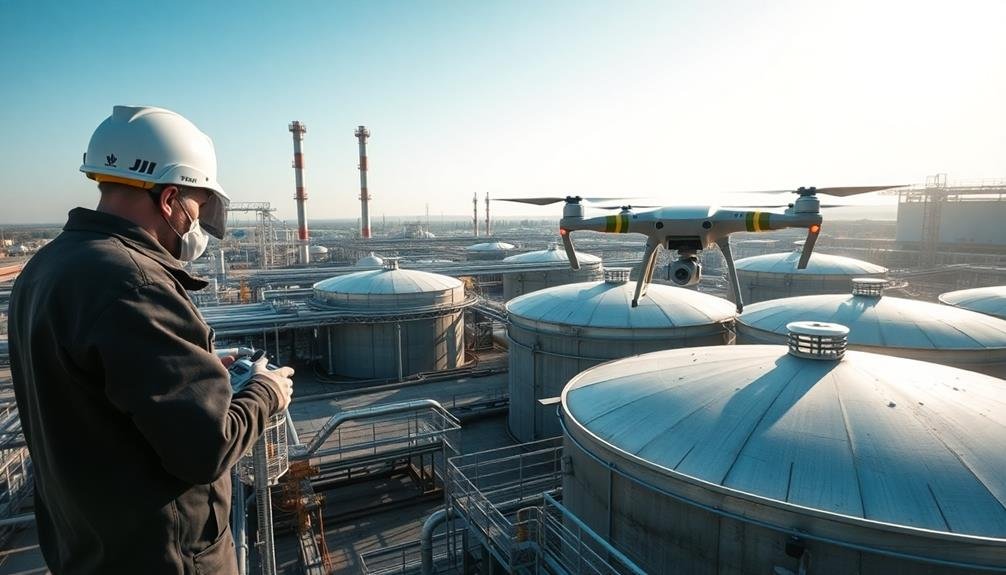
Safety protocols are paramount when conducting drone inspections in chemical plants. You must first obtain proper clearance and permits from the facility's management and safety officers. Familiarize yourself with the plant's emergency procedures and evacuation routes before starting your inspection.
Always conduct a thorough pre-flight check of your drone, ensuring all components are functioning correctly. Equip your drone with appropriate safety features, such as obstacle avoidance systems and return-to-home functionality. You'll need to maintain visual line of sight with the drone at all times during the inspection.
Be aware of potential hazards in chemical plants, including flammable gases, corrosive substances, and high-pressure systems. Keep your drone at a safe distance from these areas and avoid flying over personnel or sensitive equipment. It's vital to use intrinsically safe equipment in potentially explosive atmospheres.
Monitor weather conditions closely, as wind or precipitation can affect drone performance and safety. Establish clear communication channels with plant personnel during the inspection.
If you encounter any unexpected situations or safety concerns, immediately halt the inspection and consult with the plant's safety team. Always prioritize safety over completing the inspection.
Leverage Thermal Imaging Technology
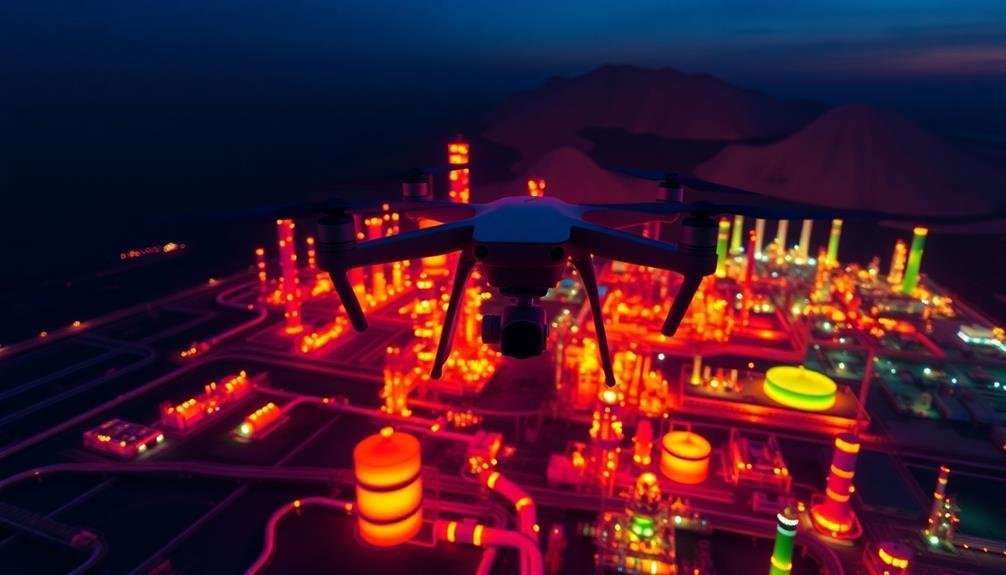
Thermal imaging technology can take your drone inspections to the next level in chemical plants. By equipping your drone with a thermal camera, you'll be able to detect temperature anomalies that aren't visible to the naked eye. This technology allows you to identify potential issues like leaks, insulation failures, or overheating equipment before they become significant problems.
When using thermal imaging, make sure you understand how to interpret the data correctly. Different materials and surfaces emit heat differently, so it's essential to calibrate your readings and account for environmental factors.
You'll want to conduct inspections during ideal conditions, typically early morning or late evening, to minimize interference from solar radiation.
Focus on key areas such as pipelines, storage tanks, and reaction vessels. Look for unexpected hot spots or cold areas that could indicate inefficiencies or malfunctions.
Don't forget to compare thermal images with visual data to get a thorough understanding of the plant's condition.
Master Data Management Techniques
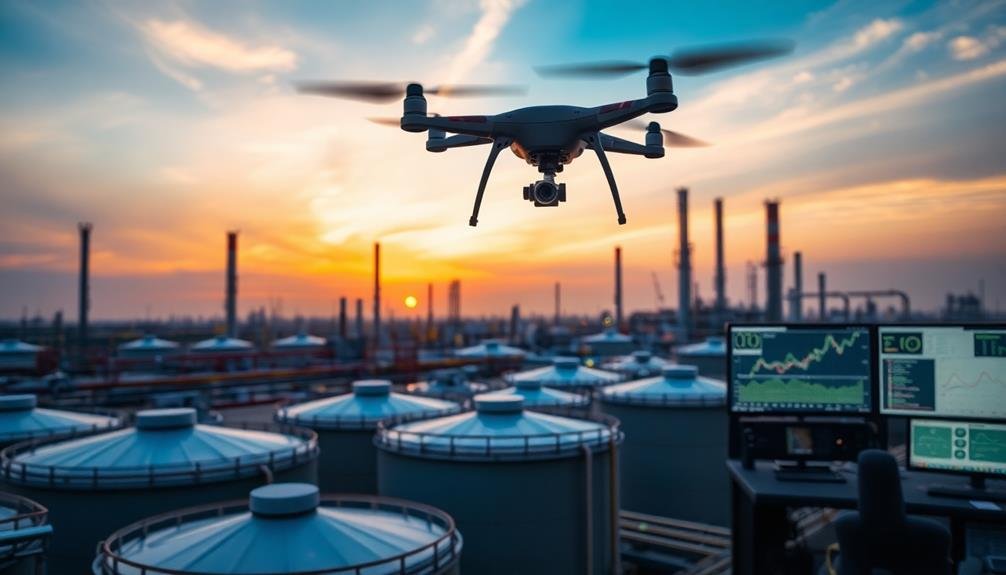
Effective data management is vital for successful drone inspections in chemical plants. You'll need to implement robust systems to handle the vast amount of data collected during these inspections.
Start by establishing a centralized database where all inspection data can be stored, organized, and accessed easily. This should include images, videos, thermal readings, and any other relevant information gathered by your drones.
Implement a standardized naming convention for all files and folders to guarantee consistency and easy retrieval. You'll want to use metadata tags to categorize and sort your data effectively. This will help you quickly locate specific information when needed.
Don't forget to set up automatic backups to protect your valuable data from loss or corruption.
Consider using cloud-based storage solutions for improved accessibility and collaboration among team members. You should also invest in data analytics tools to help you identify trends, patterns, and potential issues in your inspection results. These insights can be vital for predictive maintenance and risk assessment.
Interpret and Report Findings Effectively

Once you've collected and managed your drone inspection data, it's time to make sense of it all. Start by organizing your findings into clear categories, such as structural integrity, corrosion, leaks, or equipment condition.
Analyze the data thoroughly, looking for patterns, anomalies, or potential safety hazards. When interpreting the results, consider the context of each finding. Compare current data with historical records to identify trends or changes over time.
Don't hesitate to consult with subject matter experts to guarantee accurate interpretation of complex issues. In your report, use clear, concise language and avoid technical jargon when possible.
Include visual aids like annotated images or diagrams to illustrate key points. Prioritize your findings based on their potential impact on safety, compliance, and operational efficiency.
Be sure to provide actionable recommendations for each identified issue. Include estimated costs, timelines, and potential risks associated with both addressing and ignoring the problems.
Frequently Asked Questions
How Often Should Drone Inspections Be Conducted at Chemical Plants?
You should conduct drone inspections at chemical plants quarterly, but increase frequency for high-risk areas or after incidents. Tailor your schedule to your plant's specific needs, considering factors like equipment age, regulatory requirements, and safety concerns.
What Certifications Are Required for Drone Pilots in Chemical Plant Inspections?
You'll need a Part 107 Remote Pilot Certificate from the FAA. Additionally, you should obtain specific safety certifications for chemical plants, such as OSHA's Hazardous Waste Operations and Emergency Response (HAZWOPER) training. Don't forget site-specific authorizations.
Can Drones Detect Gas Leaks During Chemical Plant Inspections?
Yes, drones can detect gas leaks during chemical plant inspections. You'll need to equip them with specialized sensors like infrared cameras or gas detectors. They're effective for identifying leaks in hard-to-reach areas, improving safety and efficiency.
How Do Weather Conditions Affect Drone Inspections at Chemical Plants?
Weather conditions greatly impact your drone inspections. You'll face challenges with wind, rain, and extreme temperatures. They can affect flight stability, visibility, and sensor accuracy. Always check forecasts and plan accordingly to guarantee safe, effective inspections.
What Are the Legal Implications of Capturing Footage During Chemical Plant Inspections?
You'll need to take into account privacy laws, intellectual property rights, and potential security concerns. Obtain necessary permissions, guarantee confidentiality agreements are in place, and follow regulations regarding aerial footage of sensitive facilities. Don't share or publish without approval.
In Summary
You've now got the essential tips for successful drone inspections at chemical plants. Remember, careful planning and the right equipment are vital. Don't forget to prioritize safety and leverage advanced technologies like thermal imaging. Master your data management and reporting skills to make the most of your findings. With practice and attention to these key areas, you'll become an expert at drone-based chemical plant inspections in no time.

As educators and advocates for responsible drone use, we’re committed to sharing our knowledge and expertise with aspiring aerial photographers.




Leave a Reply